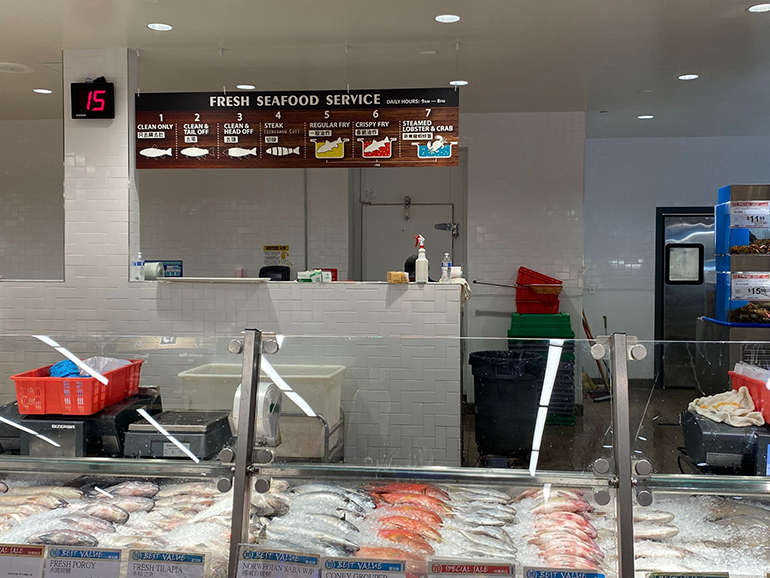The online seafood channel is a sleeping giant.
Only about 33% of all seafood consumers are purchasing fresh or frozen seafood online, a decline from 38% in 2021, states the Power of Seafood 2023 report, published by Arlington, Va.-based FMI — The Food Industry Association.
Yet, retailers have the potential to boost seafood sales, as well as overall grocery purchasing, by enhancing the digital shopping experience for seafood eaters.
The 75% of frequent seafood consumers who shop for groceries online spend an additional $273 per month on those purchases, the report states. In addition, 60% of occasional seafood consumers who also are likely to shop online spend an additional $264 per month for the online purchase of groceries.
“Despite their propensity to shop online, the migration to online specifically for seafood purchases continues to lag,” the report states. While frequent seafood consumers are more likely than occasional consumers to purchase seafood online, 45% versus 23%, “this still represents a minority of these shoppers,” the Power of Seafood notes, adding that online seafood consumers still buy less than half of their overall seafood online.

Online shopping enables consumers to avoid understaffed seafood departments.
“Many consumers are afraid of seafood,” said Rick Stein, FMI vice president of fresh foods. “They don’t understand it, don’t know how to cook it, and are missing the instore experience when shopping online.”
That experience includes the ability to speak with seafood department associates to learn more about the selections, including area of origin, freshness level, and how to best prepare the items, he said.
Because they tend to be more affluent, educated, and comfortable buying online, frequent seafood eaters are more likely to embrace online seafood purchasing, Stein said. Getting other shopper segments to buy seafood digitally, however, can be challenging. “There is a seafood learning curve that the consumers need to go through,” he said.
Digital seafood sales, however, are likely to increase as retailers make their web pages more dynamic and user friendly, Stein said. Design and functionality, he said, are the most consequential elements for merchandisers to focus on when seeking to increase online activity.
Seafood product listings on supermarket websites, for instance, often lack attractive images of selections, and layouts frequently make it difficult for shoppers to locate specific products, he said.
Ongoing technology enhancements, however, will likely enable shoppers to click on videos for each species and receive specific cooking tips, Stein said, while chat boxes, supported by artificial intelligence, will enable shoppers to submit seafood questions and receive immediate answers. He predicts that such functionality may occur within the next 18 months.
“Online shopping is an evolving technology and the way retailers present it to consumers is evolving,” he said. “It is not easy now to order seafood online as the presentation on many websites isn’t great.”
Because the seafood eater generates a higher overall basket ring, there is strong incentive to make online seafood shopping more inviting, Stein said.
Frequent and occasional seafood shoppers spend an average of $184 and $174 a week, respectively, on groceries versus $152 for the non-seafood customer, the Power of Seafood reports. When seafood is in the basket, the average spend is $99, compared to $48 without seafood.
“It is important to capture that consumer’s loyalty, even if they don’t buy seafood on a particular order, because they will still be placing a larger order than most,” he said.
Digital shopping also stimulates additional brick and mortar purchases, Stein said. “I might sit home and scroll through online ordering without placing an order, but it helps me decide what I’m going to buy when I go to the store,” he said.
Stein said information on sustainability, nutritional values, recipes, preparation methods, wild-caught versus aquaculture, and freshness are among the important seafood data that retailers should post online to spur digital ordering.
Such elements will help ease the concerns of the large base of consumers who indicate that they are reluctant to buy seafood because of unfamiliarity and not trusting themselves to prepare it correctly, Stein said. “They state that if I’m going to spend $12.99 or $19.99 a pound on something, I do not want to screw it up,” he said.
Websites also have the bandwidth to provide extensive and reliable product information.
“My store employee might not know all the answers, but I can make sure that the answer I have online is consistent and accurate,” Stein said. “There is an opportunity for online to be an educational as well as a shopping format. It is a means to communicate with seafood shoppers on their path to purchase.”





